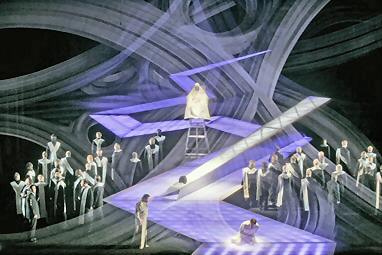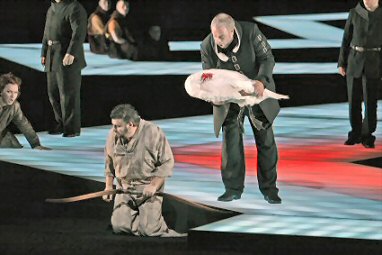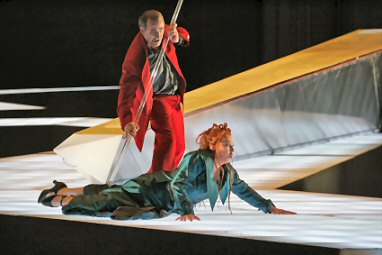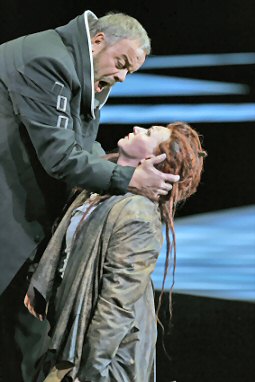|
Editor: Marc Bridle
Webmaster: Len Mullenger
|
Seen and Heard International
Opera Review
Conductor: Mikko Franck Set Designer: Hans Schavernoch
Cast: Gurnemanz: Matti Salminen Chorus and Orchestra of Finnish National Opera
This an overtly 'spiritual' production in which Wagner's underlying commitment to Schopenhauer's philosophy and his researches into Hinduism, Buddhism and Christian symbolism, are mixed together seamlessly by the explicit representation of compassion in action. 'Nothing touches me seriously, save in so far as it awakes in me fellow-feeling, that is, fellow-suffering,' Wagner wrote for Frau Wesendonck in his 'Venice Diary'. 'This compassion I recognise as the strongest feature of my moral being, and presumably it is also the fountain-head of my art.'
To illustrate the centrality of compassion from the outset, during the Prelude the curtain rises to show most of the cast (including Kundry and Klingsor) arranged round the zig-zagged illuminated pathway which appears in every scene running from front to back of the stage. At the top of the pathway, three Buddhist monks are seated observing the action, which they do repeatedly in many subsequent scenes, excepting those in Act II. As the Prelude comes to an end, sections of the stage are lowered taking Kundry and Klingsor out of sight and separating the monks from the cast.
Act I shows a tetchy Gurnemanz irritated with the attendant Knights over their indolence with the preparation of Amfortas' bath. Kundry appears bringing her balm from Arabia and Parsifal shoots a realistic swan. When the transformation to the Grail Ceremony occurs, skilled use is made of the zig-zag pathway, of a large obelisk-shaped free-floating boom (which features in other scenes in many different guises) of cathedral-like gauzes and backdrop and of the stage's capacity to raise, lower and rotate individual sections. This (and its repetition in Act III) is particularly spectacular and typical of the high-quality stage work from FNO.
In Act II Klingsor taunts Kundry mercilessly with the Spear, clearly displaying the undertones of power and sexuality that characterise their relationship. Compassion is completely absent here and Parsifal's temptations, first by the Flower Maidens (shown as a video of naked young women mixed with flower images) and later by Kundry are particularly explicit. How Amfortas succumbed to Kundry's advances is easily understood in this production, and the principals act so well here that there is real doubt as to whether Parsifal will yield too. As a final piece of stage magic, the transfer of the Spear from Klingsor to Parsifal is splendid: blink and you've missed it; don't blink and it's baffling.
In Act III, Parsifal enters,obviously confused and exhausted by his trials, and is greeted with true affection by Gurnemanz. The ubiquitous pathway glows with Spring colours to match the Good Friday music and Kundry (Magdalene-like now) washes Parsifal's feet before drying them with her hair. In the Grail Hall, the Knights grieve over Titurel's coffin and are angry at Amfortas' reluctance to perform the ceremony. When Amfortas finally picks up the Grail cup, he threatens to smash it at first and even after Parsifal heals him, he seems soul-sick and longing for death.
The Buddhist monks observe the action silently while a boy who is with them offers Parsifal a drink. When the Grail ritual is completed, the Spear is seated into a slot across the rim of the glowing cup and both are lifted skywards by the obelisk boom. The boom becomes an upright Hindu lingam topped by the spear and grail cup, which are then transformed into a dove. As their utimate gesture, the monks offer Gurnemanz, Kundry and Parsifal scarves and lead them slowly from the stage. Amfortas remains motionless below the obelisk dove/lingam: he has found his release, the ultimate compassion.
This is a superb production and certainly one of the finest that FNO has done in recent years. Apart from the innate intelligence of Harry Kupfer's direction (the production makes so much sense) everything else about it was fairly well faultless in this performance. Fine singing from all of the principals - it's hard to believe that Päivi Nisula was once a mezzo or that Jorma Silvasti was so criticised in London for his Siegmund - was matched by first-rate sets and lighting. Mikko Franck too (only 25 years old but already FNO's next Music Director) steered the orchestra and chorus masterfully through this profound and difficult score. Less obviously cerebral than Jurowski was at WNO in 2003, he clearly feels the emotion in the work acutely and great things can surely be expected of him in the future.
The most abiding memory from the production however will be the quality of the acting from the whole cast. Nisula's Kundry was genuinely seductive, Salminen's Gurnemanz was a warts-and-all human for once, and Uusitalo's Amfortas was truly sick at heart. Special mention should go though to Jorma Silvasti's Parsifal (every inch the innocent made wise by compassion) and to Esa Ruuttenen's menacing Klingsor. In his case I have often wondered whether his vocation as an ordained Christian minister helps make him such a wonderful operatic villain; if so it's a very great asset.
The major cheers must be for Harry Kupfer though: this Parsifal is a remarkable achievement.
Photographs © Stefan Bremer, Finnish National
Opera 2005
Back to the Top Back to the Index Page |
| ||
|
||||






